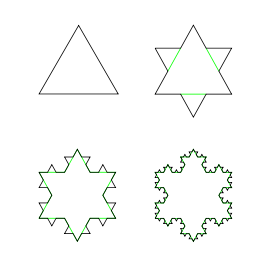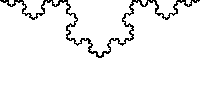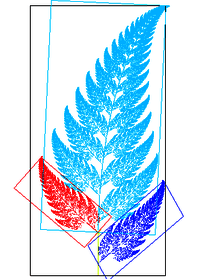Koch snowflake



The Koch snowflake (also known as the Koch curve, star. or island[1]) is a mathematical curve and one of the earliest fractal curves to have been described. It is based on the Koch curve, which appeared in a 1904 paper titled "On a continuous curve without tangents, constructible from elementary geometry" (original French title: Sur une courbe continue sans tangente, obtenue par une construction géométrique élémentaire) by the Swedish mathematician Helge von Koch.
Construction
The Koch snowflake can be constructed by starting with an equilateral triangle, then recursively altering each line segment as follows:
- divide the line segment into three segments of equal length.
- draw an equilateral triangle that has the middle segment from step 1 as its base and points outward.
- remove the line segment that is the base of the triangle from step 2.
After one iteration of this process, the resulting shape is the outline of a hexagram.
The Koch snowflake is the limit approached as the above steps are followed over and over again. The Koch curve originally described by Koch is constructed with only one of the three sides of the original triangle. In other words, three Koch curves make a Koch snowflake.
Properties
The Koch curve has an infinite length because the total length of the curve increases by one third with each iteration. Each iteration creates four times as many line segments as in the previous iteration, with the length of each one being one-third the length of the segments in the previous stage. Hence the length of the curve after n iterations will be (4/3)n times the original triangle perimeter, which is unbounded as n tends to infinity.
The fractal dimension of the Koch curve is log 4/log 3 ≈ 1.26186. This is greater than the dimension of a line (1) but less than Peano's space-filling curve (2).
The Koch curve is continuous everywhere but differentiable nowhere.
Perimeter of the Koch snowflake
After each iteration, the number of sides of the Koch snowflake increase by a factor of 4, so the number of sides after n iterations is given by:
If the original equilateral triangle has sides of length s, the length of each side of the snowflake after n iterations is:
the perimeter of the snowflake after n iterations is:
Area of the Koch snowflake
In each iteration a new triangle is added on each side of the previous iteration, so the number of new triangles added in iteration n is:
The area of each new triangle added in an iteration is one ninth of the area of each triangle added in the previous iteration, so the area of each triangle added in iteration n is:
where a0 is the area of the original triangle. The total new area added in iteration n is therefore:
The total area of the snowflake after n iterations is:
Collapsing the geometric sum gives:
Limits of area and perimeter
As the number of iterations tends to infinity, the limit of the perimeter is:
since  .
.
The limit of the area is:
since  .
.
So the area of the Koch snowflake is 8/5 of the area of the original triangle. Expressed in terms of the side length s of the original triangle this is  .[2] It is, however, wrong to state that the perimeter of the Koch snowflake is unbounded, for it is not 1-dimensional and therefore cannot be measured as an 1-dimensional line. A
.[2] It is, however, wrong to state that the perimeter of the Koch snowflake is unbounded, for it is not 1-dimensional and therefore cannot be measured as an 1-dimensional line. A  -dimensional measure exists, but has not been calculated so far. Only upper and lower bounds have been invented[3]
-dimensional measure exists, but has not been calculated so far. Only upper and lower bounds have been invented[3]
Tessellation of the plane

It is possible to tessellate the plane by copies of Koch snowflakes in two different sizes. However, such a tessellation is not possible using only snowflakes of the same size as each other. Since each Koch snowflake in the tessellation can be subdivided into seven smaller snowflakes of two different sizes, it is also possible to find tessellations that use more than two sizes at once.[4]
Thue-Morse sequence and turtle graphics
A turtle graphic is the curve that is generated if an automaton is programmed with a sequence. If the Thue–Morse sequence members are used in order to select program states:
- If t(n) = 0, move ahead by one unit,
- If t(n) = 1, rotate counterclockwise by an angle of π/3,
the resulting curve converges to the Koch snowflake.
Representation as Lindenmayer system
The Koch Curve can be expressed by a rewrite system (Lindenmayer system).
- Alphabet : F
- Constants : +, −
- Axiom : F++F++F
- Production rules:
- F → F−F++F−F
Here, F means "draw forward", + means "turn right 60°", and − means "turn left 60°".
Variants of the Koch curve
Following von Koch's concept, several variants of the Koch curve were designed, considering right angles (quadratic), other angles (Cesàro), circles and polyhedra and their extensions to higher dimensions (Sphereflake and Kochcube, respectively)
| Variant | Illustration | Construction |
|---|---|---|
| 1D, 85° angle |  Cesàro fractal | The Cesàro fractal is a variant of the Koch curve with an angle between 60° and 90° (here 85°). |
| 1D, 90° angle |  Quadratic type 1 curve |  The first 2 iterations |
| 1D, 90° angle |  Quadratic type 2 curve |  The first 2 iterations. Its fractal dimension equals 1.5 and is exactly half-way between dimension 1 and 2. It is therefore often chosen when studying the physical properties of non-integer fractal objects. |
| 1D, ln 3/ln (√5) |  Quadratic flake |  The first 2 iterations. Its fractal dimension equals ln 3/ln (√5)=1.37. |
| 1D, ln 3.33/ln (√5) |  Quadratic Cross | Another variation. Its fractal dimension equals ln 3.33/ln (√5)=1.49. |
| 2D, triangles |  von Koch surface |  The first 3 iterations of a natural extension of the Koch curve in 2 dimensions |
| 2D, 90° angle | .png) Quadratic type 1 surface | Extension of the quadratic type 1 curve. The illustration at left shows the fractal after the second iteration  Animation quadratic surface |
| 2D, 90° angle | .png) Quadratic type 2 surface | Extension of the quadratic type 2 curve. The illustration at left shows the fractal after the first iteration. |
| 3D, spheres |  Closeup of Haines sphereflake | Eric Haines has developed the sphereflake fractal, which is a three-dimensional version of the Koch snowflake, using spheres. |
| 3D, tetrahedra into cube | See Stellated Octahedron, the second recursion of the Kochcube | When tetrahedrons are recursively alternated in a pattern similar to the Koch Snowflake, the first symmetrical polyhedron to emerge is the stella octangula (or stellated octahedron), made of 8 tetrahedrons. In the third iteration, a cuboctahedron frame develops around the stellated octahedron and consists of 64 tetrahedrons (8^2). From here, the shape of a cube begins to emerge, wherein the fourth iteration forms 512 stacked tetrahedrons (8^3), with 2 octaves of cube octahedron geometry, and the fifth holds 4096 tetrahedrons (8^4). Upon further cycles of recursion, the resultant form approaches a perfect cube ad infinitum. See First Five Iterations of the 3D Kochcube |
| 3D | .jpg) Koch curve in 3D | A three-dimensional fractal constructed from Koch curves. The shape can be considered a three-dimensional extension of the curve in the same sense that the Sierpiński pyramid and Menger sponge can be considered as extensions of the Sierpinski triangle and Sierpinski carpet. The version of the curve used for the shape does not use 60-degree angles. |
Squares can be used to generate similar fractal curves. Starting with a unit square and adding to each side at each iteration a square with dimension one third of the squares in the previous iteration, it can be shown that both the length of the perimeter and the total area are determined by geometric progressions. The progression for the area converges to 2 while the progression for the perimeter diverges to infinity, so as in the case of the Koch Snowflake, we have a finite area bounded by an infinite fractal curve.[5] The resulting area fills a square with the same center as the original, but twice the area, and rotated by π/4 radians, the perimeter touching but never overlapping itself.
The total area covered at the nth iteration is :
While the total length of the perimeter is : which approaches infinity as n increases
which approaches infinity as n increases
The Koch Curve Poem
“Triangles outside triangles outside triangles ad infinitum the Koch curve goes, it's infinitely infinitesimal, this self-similarity shows. A length too great to measure, an area too small to see, what else can this contradiction be, behold fractal geometry."
See also
- List of fractals by Hausdorff dimension
- Gabriel's Horn (infinite surface area but encloses a finite volume)
- Flowsnake
- Self-similarity
- Weierstrass function
References
- ↑ Addison, Paul S. Fractals and Chaos - An Illustrated Course. Institute of Physics (IoP) Publishing (1997) ISBN 0-7503-0400-6 - Page 19
- ↑ Koch Snowflake
- ↑ On the Lower Bound of the HausdorffMeasure of the Koch Curve, http://www.researchgate.net/publication/238848353_On_the_Lower_Bound_of_the_HausdorffMeasure_of_the_Koch_Curve
- ↑ Burns, Aidan (1994), "78.13 Fractal tilings", Mathematical Gazette 78 (482): 193–196, JSTOR 3618577.
- ↑ Demonstrated by James McDonald in a public lecture at KAUST University on January 27, 2013. retrieved 29 January 2013.
- Edward Kasner & James Newman, Mathematics and the Imagination Dover Press reprint of Simon & Schuster (1940) ISBN 0-486-41703-4, pp 344–51.
External links
| Wikimedia Commons has media related to Koch curve. |
| Wikimedia Commons has media related to Koch snowflake. |
- von Koch Curve
- The Koch snowflake in Mathworld
- The Koch Curve poem by Bernt Wahl
- Application of the Koch curve to an antenna
- A WebGL animation showing the construction of the Koch surface
- "A mathematical analysis of the Koch curve and quadratic Koch curve" (PDF). Retrieved 22 November 2011.
| ||||||||||||||||||||||||||||||||||||










